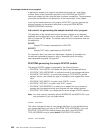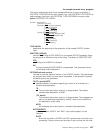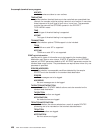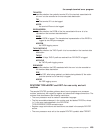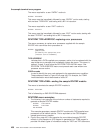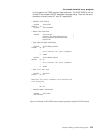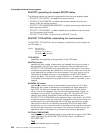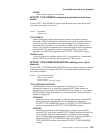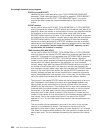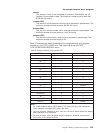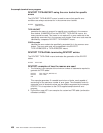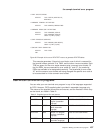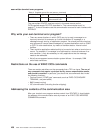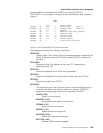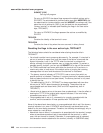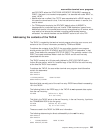CODE={errcode|BUCKET}
identifies the error code referred to by the TYPE=PERMCODE|ERRCODE
parameter. These codes are listed in Figure 22 on page 443. CODE=BUCKET
is only applicable to the DFHTEPT TYPE=ERRCODE macro. It is used to
override the default threshold constants established for the common error
bucket.
COUNT=number
can be used in either the DFHTEPT TYPE=PERMCODE or TYPE=ERRCODE
macro to override the sample DFHTEP default count threshold (see Table 20 on
page 435). When the number of occurrences of the error type specified reaches
the threshold, an error processor normally takes a logic path that causes
DFHTACP default actions to be taken. If the number of occurrences is less than
the threshold, the error processor normally takes a logic path that overrides the
DFHTACP default actions. The updating and testing of the current threshold
counts are normally performed by a DFHTEP subroutine that sets a condition
code that the error processor can test to determine whether the limit has been
reached. If you specify 0 as the number in the COUNT operand, you are
not told when the threshold is reached.
TIME=(number[,SEC|,MIN|,HRS])
can be used in either the DFHTEPT TYPE=PERMCODE or TYPE=ERRCODE
macros to override the sample DFHTEP default time threshold (see Table 20 on
page 435). This operand is only applicable when OPTIONS=TIME is specified
on both the DFHTEPM and DFHTEPT TYPE=INITIAL macros. When the
number of occurrences reaches the threshold specified on the COUNT operand
(above) within the interval specified on this parameter, an error processor
normally takes a logic path that causes DFHTACP default actions to be taken. If
the number of occurrences within the interval is less than the threshold, the
error processor normally takes a logic path that overrides the DFHTACP default
actions. If the time interval has expired, the sample DFHTEP subroutine that
normally updates and tests the current threshold count resets the occurrence
counts, and establishes a new expiration time. In this case, the condition code
set by the subroutine indicates that the thresholds had not been reached.
Time control in the sample DFHTEP starts with the first occurrence of an error
type. Subsequent occurrences of the same error type do not establish new
starting times, but are accounted for as having occurred within the interval
started by the first occurrence. This continues until an error count reaches the
threshold within the interval started by the first occurrence, or until the interval
has expired. In the latter case, the error being processed becomes a first
occurrence, and a new interval is started. A time interval of 0 means that the
number of occurrences is to be accounted for and controlled without regard to a
time interval. Zero is the implied time interval if the value of the COUNT
operand is 0 or 1. It is also the implied time interval if the time options are not
generated.
The time interval can be expressed in any one of four units; hours, minutes,
seconds, or hundredths of a second. The maximum interval must be the
equivalent of less than 24 hours. A practical minimum would be 1 to 2 minutes.
This allows for access method retries and the time required to create the task to
service each error. The four methods of expressing the threshold time interval
are:
the sample terminal error program
434
CICS TS for OS/390: CICS Customization Guide



